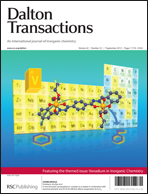Synthesis, characterisation and evaluation of a novel copper-64 complex with selective uptake in EMT-6 cells under hypoxic conditions†
Abstract
The radiometal 64Cu is now widely used in the development of diagnostic imaging agents for positron emission tomography (PET). The present study has led to the development and evaluation of a novel chelating agent for 64Cu: the new monothiourea tripodal ligand 1-benzoyl-3-{6-[(bis-pyridin-2-ylmethyl-amino)-methyl]-pyridin-2-yl}-thiourea (MTUBo). X-ray crystallographic analysis has shown this ligand forms a mononuclear complex with copper(II) and co-ordinates via a trigonal bipyramidal N4S array of donor atoms. Promisingly, cell uptake studies revealed that 64Cu-MTUBo selectively accumulates in EMT-6 cells incubated under hypoxic conditions which may result from its relatively high CuII/I redox potential. Small-animal PET imaging and ex vivo biodistribution studies in EMT-6 tumor bearing BALB/c mice revealed significant tumor uptake after 1 h p.i., yielding tumor-to-muscle (T/M) and tumor-to-blood (T/B) ratios of 8.1 and 1.1, respectively. However, injection of 64Cu-acetate resulted in similar uptake indicating that the observed uptake was most likely non-specific. Despite showing high in vitro stability, it is likely that in vivo the complex undergoes transchelation to proteins within the blood in a relatively short timeframe. For comparison, the hypoxia imaging agent 64Cu-ATSM was also evaluated in the same murine tumor model and showed about 60% higher tumor uptake than 64Cu-MTUBo.


 Please wait while we load your content...
Please wait while we load your content...